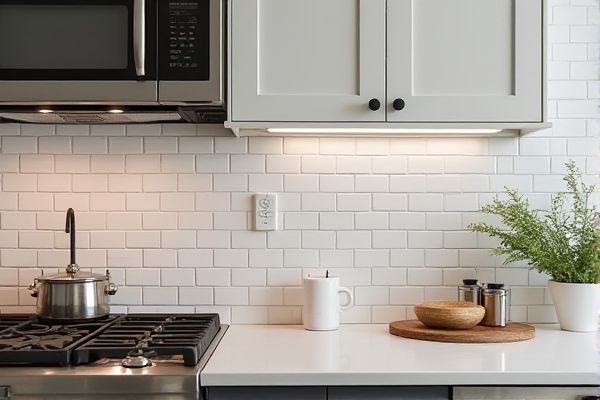
Brick backsplashes offer a rustic, textured look that adds warmth and character to your kitchen, while subway tiles provide a sleek, classic design with easy maintenance and versatility. Explore this article to discover which backsplash option suits your style and functional needs best.
Table of Comparison
| Feature | Brick Backsplash | Subway Tile Backsplash |
|---|---|---|
| Material | Natural or faux brick | Glazed ceramic or porcelain tiles |
| Appearance | Rustic, textured, industrial style | Smooth, clean, classic look |
| Installation | Heavier, requires mortar or adhesive | Lightweight, easy to install with tile adhesive |
| Maintenance | Porous; needs sealing, may collect dirt | Easy to clean, water-resistant surface |
| Durability | Very durable but can chip or crack | Highly durable and resistant to stains |
| Cost | Higher due to material and labor | Generally affordable and cost-effective |
| Style Compatibility | Industrial, rustic, farmhouse | Modern, traditional, minimalist |
Introduction to Brick vs Subway Tile Backsplashes
Brick backsplashes offer a rustic, textured aesthetic that brings warmth and character to kitchens, often made from natural or faux brick materials designed for durability against heat and moisture. Subway tile backsplashes feature a clean, classic look with smooth, glossy surfaces and uniform rectangular shapes that enhance easy cleaning and versatility in various kitchen styles. Both materials provide distinct design benefits, with brick emphasizing a rugged, vintage vibe and subway tile delivering a sleek, timeless appeal.
Aesthetic Differences Between Brick and Subway Tile
Brick backsplashes evoke a rustic, textured aesthetic with natural variations in color and surface, offering a warm, earthy ambiance ideal for farmhouse or industrial-style kitchens. Subway tiles provide a sleek, uniform look with clean lines and a glossy finish that enhances brightness and fits modern, minimalist, or classic decors effortlessly. The choice between brick and subway tile backsplash significantly impacts kitchen style, with brick emphasizing rugged charm and subway tile delivering timeless sophistication.
Durability and Longevity Comparison
Brick backsplashes offer exceptional durability due to their thick, solid construction and resistance to impact, making them ideal for high-traffic kitchens. Subway tile backsplashes provide strong longevity with their glazed surface that resists stains, moisture, and heat, ensuring easy maintenance over time. Both materials withstand kitchen wear, but brick may require sealing to prevent staining, while subway tiles maintain their appearance with minimal upkeep.
Maintenance and Cleaning Requirements
Brick backsplashes require regular sealing to prevent staining and moisture absorption, making their maintenance more intensive and frequent. Subway tile backsplashes offer a smooth, non-porous surface that is easy to clean with simple wiping, reducing the effort needed to maintain them. Your choice depends on how much time you are willing to invest in upkeep to keep your backsplash looking pristine.
Cost Analysis: Brick vs Subway Tile
Brick backsplashes generally cost more due to higher material and installation expenses, averaging between $15 to $30 per square foot. Subway tile offers a budget-friendly alternative, with prices ranging from $5 to $15 per square foot, including labor and materials. Your choice depends on balancing aesthetic preference with budget constraints for an effective kitchen upgrade.
Installation Process and Complexity
Brick backsplashes require more extensive preparation, including sealing and cutting irregular shapes, making the installation process labor-intensive and time-consuming. Subway tile backsplashes offer a straightforward installation with uniform tiles, allowing for quicker alignment and grouting, ideal for DIY enthusiasts or those looking for a simpler project. Your choice depends on whether you prefer the rustic charm of brick with its installation challenges or the sleek, manageable process of subway tile.
Design Versatility and Style Options
Brick backsplashes offer a rustic and textured appearance that complements industrial, farmhouse, and traditional kitchen designs, providing warmth and character. Subway tiles deliver a sleek, classic look with clean lines, available in various colors and finishes, making them ideal for modern, minimalist, and transitional spaces. Your choice between brick and subway tile backsplash should align with your overall kitchen aesthetic and desired ambiance, balancing texture and style versatility.
Pros and Cons of Brick Backsplashes
Brick backsplashes offer a distinctive, rustic aesthetic that adds warmth and texture to your kitchen, while providing durability and heat resistance. However, their porous surface can absorb stains and grease, requiring regular sealing and maintenance to keep them looking fresh. Brick backsplashes may also be harder to clean and install compared to smoother alternatives like subway tiles, which offer a sleek, easy-to-maintain surface with a timeless appeal.
Pros and Cons of Subway Tile Backsplashes
Subway tile backsplashes offer a sleek, timeless look with easy-to-clean, durable surfaces, making them highly popular in kitchen design. Their uniform shape and glossy finish reflect light, enhancing kitchen brightness, but grout lines can accumulate dirt and require regular maintenance. Limited color and pattern variety may restrict design creativity compared to rustic brick backsplashes, which provide unique texture but less uniformity and more porous surfaces.
Which Backsplash is Best for Your Space?
Brick backsplashes offer a rustic, textured look that adds warmth and character to kitchens with traditional or industrial design themes. Subway tile backsplashes provide a clean, versatile aesthetic with easy-to-clean surfaces, making them ideal for modern or minimalist spaces. Your choice depends on whether you prefer the cozy, tactile appeal of brick or the sleek, low-maintenance functionality of subway tiles for your space.
 homyna.com
homyna.com